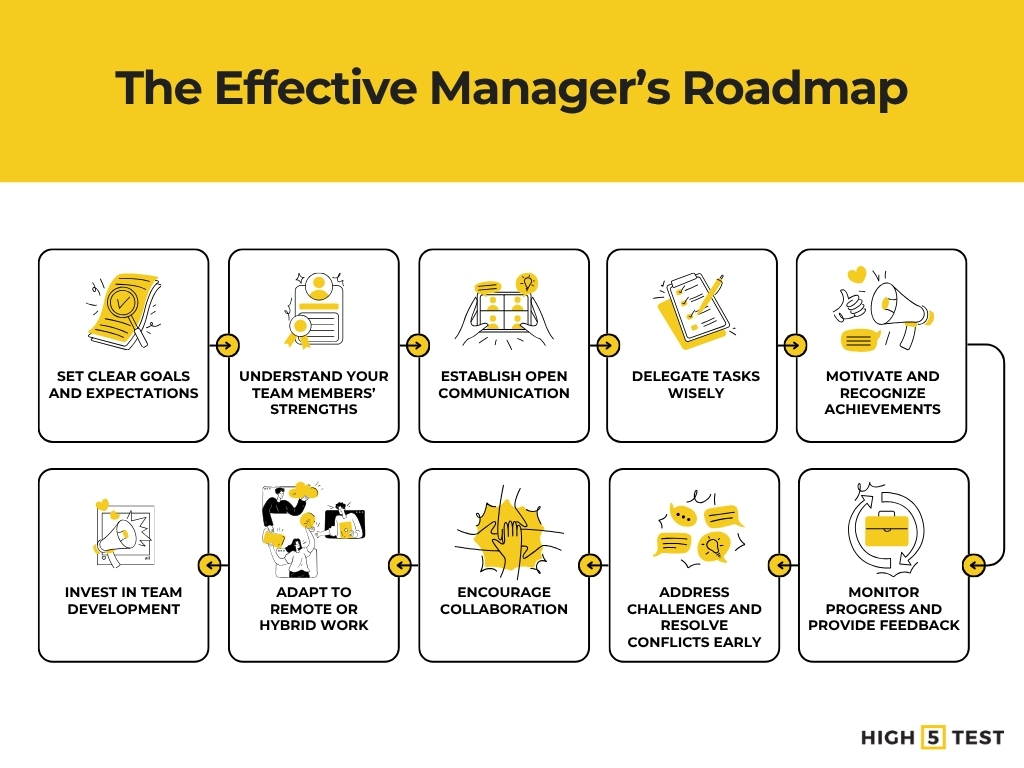Effective team management means aligning people and tasks so that projects stay on track while team members stay engaged. It involves communicating goals clearly, listening to team members, and motivating them to reach shared objectives.
Teams that focus on strengths and responsibilities tend to perform better. Research indicates that this approach can lead to 39% higher productivity and 74% greater engagement. Good management also fosters a positive culture – happier employees can boost performance by ~20%. Below, we outline key skills and steps for leaders to manage and develop a high-performing team.

What is team management?
Team management is a manager’s ability to coordinate all members to execute tasks and achieve common goals. It involves planning, organizing, and guiding the team by setting a clear direction, communicating regularly, and creating a positive environment.
Related: Communication in the Workplace Statistics
When teams feel supported and informed, they become more productive and loyal. In fact, managers who engage their team often see lower turnover and higher performance. Strong team management keeps everyone aligned with company objectives while maintaining motivation across the group.
5 key skills for effective team management
Effective managers develop several core skills. These skills help managers juggle business demands with individual needs, fostering trust and clarity. To continuously improve, managers can seek training and feedback on these skills.
1. Communication & listening: Clearly share expectations and listen to feedback. Strong communication ensures everyone understands tasks and deadlines.
2. Delegation: Assign tasks based on each person’s skills and workload. Effective delegation (possibly with help from workload tools) balances tasks fairly.
3. Empathy & motivation: Understand team members’ strengths and challenges. Managers should motivate individuals and recognize achievements to boost morale.
4. Adaptability: Be ready to change plans as needed. Adapting leadership style (like coaching vs. hands-on) suits different team situations.
5. Goal setting: Set and share clear short-term and long-term goals. Managers who keep goals visible help maintain momentum and focus.
How to align roles with team strengths
A valuable modern approach to building stronger teams is assessing both individual and group strengths. Tools like the HIGH5 test for team building help identify each member’s top strengths and how they complement each other. Focusing on what people excel at allows managers to assign roles more effectively and reduce unnecessary conflict.
HIGH5’s data shows that teams aware of their strengths see higher profitability (17%) and engagement (74%) compared to teams that don’t. Using such assessments supports better task delegation, smarter project pairings, and clearer interpersonal dynamics.
Team analytics that drive smarter management
Data insights help improve how teams are managed. Team analytics platforms (like HIGH5 Team Analytics) visualize team composition and performance. The HIGH5 Team Strengths Grid shows how each member’s strengths overlap and where the team as a whole excels.
It also helps identify overused strengths that may create imbalances. This allows managers to adjust before problems develop. Analytics also map the team’s working style (like people-oriented vs. action-oriented) to adapt leadership accordingly. Managers can review these insights in easy reports or facilitated team sessions to spark discussion on improvement. These tools make team dynamics easier to understand and support better decision-making.
Managing teams with modern platforms
Modern management is aided by technology. Project and workflow platforms (like Asana, Monday.com) can help track tasks, deadlines, and workloads. This allows managers to spend more time focusing on their teams. In addition, strengths-based assessment tools such as HIGH5’s strength reports, along with team analytics dashboards, bring psychological insight into management.
These resources help managers learn more about each team member and measure team health. For example, HIGH5’s Group Fit feature allows scenario planning for new hires by comparing candidate strengths against the current team. This ensures new additions bring balance and value. Using these tools regularly creates a cycle of continuous improvement. Teams can assess their performance, reflect on results, and plan targeted development actions.
Developing and growing the team
Managing a team also means investing in its growth. Encourage continuous learning through training, mentoring, and stretch projects. Use feedback and analytics to spot skill gaps or disengagement early. For example, if data highlights a missing strength, such as strategic thinking, arrange targeted training or coaching. Schedule periodic team workshops (using HIGH5’s ready-made facilitator guides, if available) to build skills like communication or problem-solving as a group.
Promote a culture that values learning from mistakes. Set personal development goals for each team member. When growth is made a priority, people feel recognized and are more likely to stay.
10 steps to manage a team effectively
Managing a team well requires more than just assigning tasks. It involves setting direction, building trust, and creating the right environment for people to do their best work. The following steps help managers lead with clarity and impact.

Step 1: Set clear goals and expectations
Define both the big picture and short-term objectives. Communicate deadlines, priorities, and success measures. When managers set a clear project vision and OKRs, team members know what to prioritize.
Step 2: Understand your team members’ strengths
Use tools like the HIGH5 Personality Test for Teams to map out individual and collective strengths. Delegate tasks based on who is naturally best at what. This reduces friction and boosts motivation.
Step 3: Establish open communication
Keep communication open and direct. Create regular feedback loops: weekly check-ins, stand-ups, or 1:1s. For example, use team meetings or dashboards so everyone knows progress and next steps. Use collaboration tools (Slack, Teams, Asana) to maintain transparency.
Step 4: Delegate tasks wisely
Assign tasks strategically. Match work to people’s strengths and capacity, so no one is overloaded. Avoid micromanagement and trust your team once tasks are assigned. For instance, workflow automation can help distribute tasks based on the current workload.
Tip: Use Team Analytics to visualize workloads and blind spots.
Step 5: Motivate and recognize achievements
Celebrate milestones, even small wins(public praise, career development opportunities, etc.). Constructive feedback helps individuals improve, while recognition boosts motivation. Employees feel valued when their efforts are noticed.
Step 6: Monitor progress and provide feedback
Regularly track KPIs and overall team performance to stay aligned with goals. Offer constructive feedback rather than just criticism, and be prepared to adjust strategies when something isn’t working.
Step 7: Address challenges and resolve conflicts early
Stay proactive in spotting issues. Address issues early and fairly. Understanding each person’s strengths and style can prevent misunderstandings. Use empathy and fairness when mediating. Tools like strengths assessments help here – teams that know each other’s strengths communicate better and have fewer conflicts.
Step 8: Encourage collaboration
Foster a cooperative environment. Use collaborative tools and encourage input so members feel connected and engaged. Team collaboration often leads to better ideas and faster problem-solving.
Step 9: Adapt to remote or hybrid work
For distributed teams, use clear plans and frequent check-ins. Establish a remote work plan to align schedules and feedback loops. Research shows frequent feedback (like weekly) keeps remote employees 3.6× more engaged than annual reviews.
Step 10: Invest in team development
Provide training, coaching, and growth opportunities. Schedule workshops or team-building activities to strengthen collaboration and skills. Continuously revisit goals and celebrate improvement to keep the team motivated and aligned.
Conclusion
Leading a team successfully is a balance of strategy and empathy. Mastering key skills like communication, delegation, and goal setting helps managers keep projects aligned and teams engaged. Clear communication, defined objectives, and consistent feedback build trust and maintain momentum.
Using strengths-based tools such as the HIGH5 personality test and team analytics adds a powerful layer of insight. These tools help align people with roles and identify areas for growth. In essence, great team management means coordinating resources and developing people. The result is a high-performing team that achieves goals and continuously improves.
FAQ
What makes a team well-managed?
A well-managed team has clear goals, open communication, and strong alignment between roles and individual strengths. Managers build trust, delegate tasks effectively, and keep motivation high through regular feedback and recognition.
How can I match people to the right roles?
Start by understanding each person’s strengths using tools like the HIGH5 personality test. These insights help you assign tasks that fit natural abilities, which improves both productivity and morale while reducing conflict.
What tools support modern team management?
Platforms like Asana and Monday.com help track progress, while tools like HIGH5 offer deeper insight into team strengths and group dynamics. These resources simplify planning, communication, and decision-making, especially in remote or hybrid setups.
How do I encourage team growth and development?
Support learning with training, mentoring, and stretch assignments. Use analytics and feedback to spot gaps or disengagement early, then tailor development plans. Group workshops also help build shared skills and boost collaboration.
What are the most important skills for team leaders?
Key skills include communication, delegation, empathy, adaptability, and goal setting. These help leaders manage work efficiently, respond to challenges, and keep the team focused and engaged.


![Team Building Activities Definition & Lists [2021] High5](https://high5test.com/wp-content/uploads/2021/10/Team-Building-Activities-Definition-Lists-2021-High5-300x187.jpg)